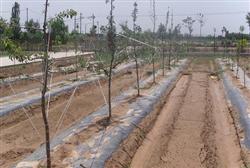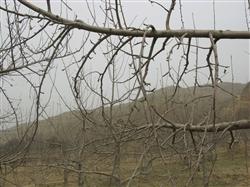How to plant apple trees?

How to plant apple trees? Please give guidance on the planting methods of apple trees can refer to the following methods: 1. seedling cultivation technique New rootstocks and new varieties are all used in new orchards. It is recommended that apple seedlings use the unique wild sweet tea rootstock in Yimeng Mountain. The local name (sweet tea has high wild degree, strong soil adaptability, disease resistance, drought and flood resistance and long life span) in order to improve the quality of the newly-built orchard, strict soil preparation, adequate bottom fertilizer, dig the value pit according to the required density before planting, the specification is 0.6mx0.6m deep 0.6 m. Separate the bottom soil from the topsoil, apply bottom fertilizer / mu fertilization (organic fertilizer) 1500kg-2000kg, according to the local soil can apply more organic fertilizer with fine sandy soil, (can add a small amount of nitrogen fertilizer per 0.1kg potash fertilizer 0.2km compound fertilizer 0.2kg) and topsoil mixed backfill to the ground 15cm, trample, make full use of land resources, plant spacing 2mx2m, can also dig planting ditch 0.6mx0.6m, irrigation in the hole 3-4 days before planting Soak in a solution with 700 times thiophanate methyl or 500 times carbendazim for one day and night before planting to fully absorb water and disinfect the seedlings. After soaking, the roots of the seedlings are dipped in the mud equipped with rooting powder, watered in time after planting, covered with plastic film to moisturize, and drained in time to prevent the seedlings from yellowing and dung loss. Two. seedling shaping and pruning mainly advocates spindle shape. The result of the spinning shape is relatively early, and it is a kind of tree shape advocated at present, with a tree height of 2.5 won 3. With a crown width of 1.8 meters and a stem height of 70 cm, 15 main branches are uniformly planted on the central trunk, regardless of hierarchy, the spacing between the main branches is 15 ~ 20 cm, evenly distributed around, and the opening angle of the main branch is up to 60 ~ 90 degrees. This kind of tree crown is small and easy to manage, flowering in the same year, fruiting in two years, and the production can be greatly increased in three to four years. Seedling pruning is mainly plastic surgery, which is generally carried out in early spring, leaving none of the skirt branches below the trunk 70cm, one branch per 20cm above 90cm, to choose a good direction, growth length in 80cm are not cut, all flattened and sprouted, 50-30cm cut head to promote new branches, next year, the central trunk is not truncated, but every 20cm ring is cut to promote branch growth evenly. From May to June, it is necessary to twist the top in time, control the heart, and cut the trunk of the robust tree to promote the differentiation of flower buds. If the branches are too exuberant, they can be treated with paclobutrazol to control the growth of branches and promote the increase and fullness of flower buds. Third, fruit tree pruning 1. Spring pruning: from sprouting to flowering, pruning tasks are completed by means of bud wiping, branch thinning, retraction, sprouting, ring peeling and other measures, and pruning tasks such as branch pulling are also included in young orchards. two。 Summer pruning: the techniques of opening angle, coring, twisting, ring peeling, thinning and ring cutting are adopted to ease the tree potential, improve the light and expand the crown. 3. Autumn shearing: through drawing branches, thinning erect branches, growing branches, dense branches and over-dense peripheral shoots and other measures to improve light conditions, promote flower bud differentiation, and improve the cold resistance of trees. 4. The pruning in the dormant period is from falling leaves in winter to before sprouting in spring. The main task is to remove some useless branches, such as disease and insect branches, dense branches, overgrown branches, etc., by cutting short backbone branches, shrinking oversized fruiting branches, auxiliary branches and weak backbone branches. Its function is to adjust the angle and extension direction of backbone branches, auxiliary branches and fruiting branches, control the proportion of flower leaves and buds, and balance tree potential. In order to achieve the purpose of high yield and high yield. pest control in the unopened grass spring, 0.5 o Shiliu mixture was used to spray seedlings, mainly for crop sterilization and overwintering pest control, according to the season to control the following diseases and insect pests, 1. (early defoliation of apple:) is the general name of several diseases of apple leaves. Among them, brown spot disease and leaf spot disease (caused by virulent strains of ring spot pathogen) are the two causes of serious leaf loss. Brown spot is mainly harmful to adult leaves, and leaf spot mainly infects young leaves. There are two peaks in spring and autumn shoots. The pathogen overwinters on diseased leaves and then spreads by Rain Water spatter. Prevention and treatment: do a good job of clearing the garden during the dormant period, sweep the fallen leaves and burn them. Spraying to protect leaves during the growing period, the brown spot was controlled with 50% carbendazim or 50% methyl topiramate 800: 1000 times, or 1: (2: 3): 240 times Bordeaux solution. Control of rosette disease with carbendazim or methyl topiramate, 2. Red spider diseases and insect pests; (if the pest population density is high before wheat harvest, you can spray 20% methanesulfite emulsion 3000 times, or 20% mites dead or 10% Keshengjing 2000 times. ) 3. Small apple leaf roll moth; (overwintering with the first instar larvae in the gaps of bark and saws. The next spring spit silk decorated leaves or flowers for harmful leaves, gnawing on the pericarp. Prevention and treatment: scrape off the old bark and burn it during the dormant period. When the larvae are near the stinging period, the sawing mouth is closed with 50% trichlorfon 200 × 250 times liquid to reduce the source of insects. During the occurrence of adults, sugar and cheese cans were hung in apple orchards to trap and kill. The proportion of sugar and vinegar is 1 part of sugar, 3 parts of vinegar and 10 parts of water. The first generation larvae were sprayed with 1000 times of dichlorvos or 2000-4000 times of pyrethroids. Note: in general, diseases and insect pests grow on the bottom of the leaves, and the leaf bottom is mainly sprayed when spraying pesticides. 5. It is important to recommend high-quality apple seedlings to choose high-quality apple seedling rootstocks. Sweet tea rootstocks grafted apple roots are sand yellow roots, other apple rootstocks are red and black. With genetic properties, poor disease resistance and short life span, apple seedling varieties are divided into early-maturing, mid-maturing and late-maturing, early-maturing varieties; Gala; Tengmu No. 1; mid-May maturing, mid-maturing variety USA No. 8; maturing in early August, late-maturing variety Fuji From the beginning of September to the middle of the lunar calendar, the above varieties are divided into dwarfing and long branches. dense planting, high yield, good fruit shape, high sweetness, high seasonal and strong regular management can greatly increase the yield of flower buds in two years and three years. Click to get more apple tree planting techniques click to get more fruit planting techniques
- Prev

How to fertilize and pull branches for apple trees
How to fertilize and branch apple trees? Please introduce in detail 1. Apple tree fertilization (1) from the outer edge of the crown, dig an annular ditch 30 cm wide and 40 cm deep (young trees) in the ground. Big trees should dig an annular ditch 50 cm wide and 60 cm deep. (2) the square of Shungou can be used in adult orchards.
- Next

What should I pay attention to when cutting apple trees in winter?
What should I pay attention to when cutting apple trees in winter? Please instruct the apple trees to pay attention to the following points in winter pruning: ① look at the tree age: young trees and early fruit trees should be trimmed less, the degree of pruning should be light, pay attention to the cultivation of tree type and fruiting branch group; trees should be properly re-pruned in full fruit period, pay attention to rotation fruiting branch group; heavy pruning of senescent trees, renew fruiting branch group. ...
Related
- Moge, come on! The staff of the peasant association in the producing area of cantaloupe were frightened when the crowd gathered.
- Causes and Solutions of low Fruit setting rate of Apple
- Symptoms and control measures of passion fruit virus disease
- Fruit growing lesson: how do apple orchards keep high yields?
- Can you build orchards in the mountains? What are the pros and cons?
- How to manage the coloring period of Crisson grape?
- This paper introduces the processing technology of two kinds of fig products.
- How much is a month for retired teachers in rural areas by 2020?
- How can strawberry planting increase sugar content? We should pay attention to management in many aspects.
- What are the cultivation techniques on how to improve the yield of golden fruit?

